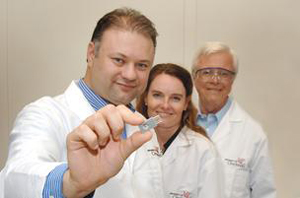Feb 14 2014
In 2010, Ian Papautsky, associate professor in the University of Cincinnati's College of Engineering and Applied Science’s Department of Electrical Engineering and Computer Systems, formed a strategic partnership with renowned researchers from two other UC colleges—Erin Haynes, assistant professor in the College of Medicine’s Department of Environmental Health, and William Heineman, professor in the McMicken College of Arts and Sciences’ Department of Chemistry—to create a low-cost, portable sensor that could detect metal levels in a human blood sample. More specifically, he wanted to make a point-of-care sensor that would rapidly analyze (in real-time, 10 minutes or less) and detect dangerous amounts of manganese in children that could be administered by a person without a medical degree.
 From left to right: Ian Papautsky, Erin Haynes, and William Heineman showcase the new sensor
From left to right: Ian Papautsky, Erin Haynes, and William Heineman showcase the new sensor
Through the combination of lab-on-a-chip sensing and microfluidics, the sensor measures manganese and lead levels in a sample consisting of merely a few drops of human blood. It will also be able to test for the presence of lead and cadmium, both of which have been shown to induce health risks. The sensor’s point-of-care design provides faster results than traditional blood testing methods (which take three to nine months to return from the laboratory), while being more convenient and environmentally friendly. There’s a potential for the sensor to be disposable and low-cost.
Additionally, Papautsky plans to go straight to the source of these metal toxins by giving the sensor the ability to monitor water (both bodied and surface) for chemical spills/pollutants.
Papautsky’s goal is to eventually commercialize the sensor for four main target markets:
- Industry: Organizations/industries will be able to test whether they are in compliance with Center for Disease Control (CDC) regulations by using the sensor.
- CDC: The CDC will be able to test whether organizations/industries are in compliance with its regulations by using the sensor.
- Academia: Researchers in academia will be able to use the sensor to better understand how manganese (and other metals) exposure affects human health and the environment.
- Home monitoring: Individuals, specifically those living in rural environments with heavy exposure to dangerous metals, will be able to test themselves in their home.
The sensor would enable a wide range of studies. For example, it also serves a purpose in Haynes’ CARES (Communities Actively Researching Exposure Study) project which she leads in eastern Ohio communities. CARES is a partnership between UC and numerous communities that is studying the effects of air pollution on child neurodevelopment.
Papautsky and the team have received two NIH (National Institutes of Health) grants to begin and continue development of the sensor: 1) R21 two-year grant (September 2010-August 2012) worth $425,000; and 2) RO1 four-year grant (October 2013-2017) worth $1.55 million.
Three years ago, the NIH R21 grant allowed Papautsky the chance to demonstrate a proof-of-concept version of the sensor. In its early stages, the sensor posed a few obstacles including: 1) surface chemistry challenges; 2) the challenge of working with extremely small blood sample sizes (which are ideal for children); and 3) the challenges of working with biological samples due to the high concentrations of protein.
The most recent grant awarded to the team—the four-year RO1 grant—enables the team focus their efforts on the sensor’s prototype. They wish to reduce its size and make the sensor itself a USB port. The team plans to field test the sensor in Marietta, Ohio, where high concentrations of manganese can be found and is a growing problem to citizens’ health. UC has already filed provisional patents for the sensor.
Papautsky explains, "While we are still in the pre-commercialization stage, we are now positioned to fully develop the sensor system for point-of-care application. It shows great potential to generate significant revenue but more importantly, it will save human lives.”
This will be the third annual Cincinnati USA Innovation Awards, celebrating innovative companies and people that show how new ideas can be developed into fuel for the Tri-State's economic engine.
For more information about the development of the sensor, please visit: http://healthnews.uc.edu/news/?/23304/
For more information about the College of Engineering and Applied Science, please visit: http://ceas.uc.edu/